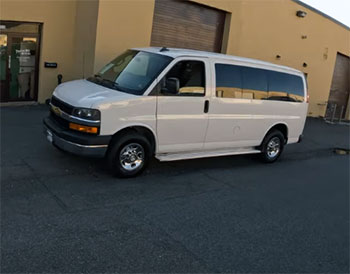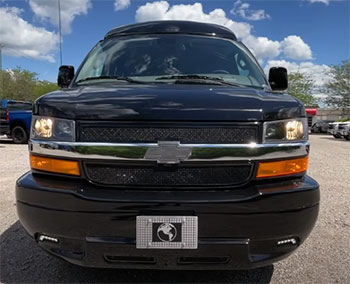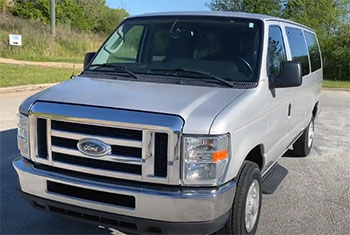As a small business owner who’s spent years hauling cargo, towing trailers, and navigating city streets, I’ve had my hands on both the Chevrolet Express and Ford Econoline vans. My goal in this article is to share my firsthand experiences, breaking down the strengths and weaknesses of these iconic workhorses to help you decide which van suits your needs.
V Whether you’re a contractor, camper, or fleet manager, I’ll compare their performance, reliability, and features in a way that’s clear and practical. Below, you’ll find a comparison table, followed by detailed insights into my time with each van.
Chevrolet Express vs. Ford Econoline Comparison
| Feature | Chevrolet Express | Ford Econoline |
|---|---|---|
| Model Years Compared | 2008-2024 | 2004-2014 |
| Base Price (2024) | ~$43,795 | Discontinued (used ~$10,000-$20,000) |
| Engine Options | 4.3L V6, 6.6L V8 | 4.6L V8, 5.4L V8, 6.8L V10 |
| Fuel Economy (City/Hwy) | 13-17 mpg / 19-22 mpg | 11-14 mpg / 15-20 mpg |
| Cargo Volume (Max) | 299.4 cu. ft. | 278.6 cu. ft. |
| Passenger Capacity | Up to 15 | Up to 15 |
| Towing Capacity (Max) | 10,000 lbs (6.6L V8) | 10,000 lbs (6.8L V10) |
| Drivetrain | RWD, optional AWD (older models) | RWD |
| Transmission | 6-speed or 8-speed automatic | 4-speed or 5-speed automatic |
| Interior Features | Basic infotainment, optional power windows/locks | Basic, some models with power windows/locks |
| Reliability | High, with proper maintenance | High, known for durability |
| Aftermarket Support | Moderate, less common for 4×4 conversions | Strong, especially for 4×4 conversions |
My Experience With the Chevrolet Express

I first got behind the wheel of a Chevrolet Express in 2010, a used 2008 model with a 5.3L V8, for my plumbing business.
It was a 2500 cargo van, and I needed something reliable to carry tools, pipes, and occasionally tow a small trailer. The Express felt like a tank—solid, dependable, and ready for anything I threw at it.
Over the years, I’ve driven newer models, including a 2021 Express 3500 with the 6.6L V8, and it’s been a consistent performer.
The van’s design hasn’t changed much since the ‘90s, which is both its charm and its drawback. It’s like driving a time capsule, but one that gets the job done.
The Express excels in simplicity. The cabin is no-frills, with straightforward controls and a focus on functionality. I appreciated the spacious cargo area, especially in the extended wheelbase version, which swallowed up my gear without breaking a sweat.
On the road, it handles better than you’d expect for a big van, with a smooth ride that makes long hauls tolerable. The 6.6L V8 I tested recently had enough grunt to tow a 7,000-pound trailer without hesitation, and the fuel economy, while not stellar, was manageable for a vehicle of its size.
However, the Express isn’t perfect. The interior feels dated, and the lack of modern tech can be a letdown if you’re used to newer vehicles. I also noticed that the door hinges on older models could get finicky, requiring regular maintenance to avoid issues. Despite these quirks, the Express has been a reliable partner for my business, and I’ve seen it shine in everything from delivery services to camper conversions.
Read More: My Thoughts On Acura MDX Vs. Volvo XC90
Pros of the Chevrolet Express
- Powerful engine options: The 6.6L V8 is a beast, delivering up to 401 horsepower and 464 lb-ft of torque, making it ideal for towing heavy loads or carrying substantial cargo. Even the base 4.3L V6 has enough power for most small business needs.
- Spacious cargo area: With up to 299.4 cubic feet of cargo space in the extended wheelbase model, I could fit an entire workshop’s worth of tools, ladders, and materials without Tetris-level packing skills.
- Smooth ride quality: Despite its size, the Express handles surprisingly well, especially on highways. The suspension absorbs bumps better than I expected, reducing fatigue on long drives.
- Reliability with maintenance: My 2008 Express clocked over 200,000 miles with only routine maintenance—oil changes, fluid flushes, and occasional brake work. It’s built to last if you treat it right.
- Affordable starting price: At around $43,795 for a new 2024 model, it’s one of the more budget-friendly options in the full-size van market, especially compared to newer competitors like the Ford Transit.
- Optional AWD in older models: While not standard, some older Express models offered all-wheel drive, which was a lifesaver for navigating snowy job sites or rural roads.
- Versatile configurations: Available in 1500, 2500, and 3500 models, with passenger or cargo setups, it’s adaptable for everything from family trips to commercial fleets.
The Express’s engine lineup is a standout. The 6.6L V8 I drove in the 2021 model felt effortless when towing, and even the 4.3L V6 in a 2015 model I borrowed for a weekend move was peppy enough for city driving. The cargo space is another win—during a particularly busy season, I managed to fit two full pallets of plumbing supplies in the back, with room to spare. The ride quality surprised me; even loaded down, the Express didn’t wallow or bounce like some older vans I’ve driven.
Reliability is a big plus—my 2008 model soldiered on through years of heavy use, and I’ve heard similar stories from other owners. The affordability makes it accessible for small businesses, and the AWD option, though rare, gave me confidence in tricky conditions. Overall, the Express is a practical, no-nonsense choice that doesn’t try to be flashy but delivers where it counts.
Cons of the Chevrolet Express

- Dated interior design: The cabin feels like it’s stuck in 1996. Basic gauges, minimal tech, and hard plastics make it less inviting than modern competitors.
- Limited advanced tech: You won’t find features like blind-spot monitoring or adaptive cruise control. The infotainment is bare-bones, with no standard touchscreen in most models.
- Mediocre fuel economy: Even with the V6, I averaged about 13 mpg in the city and 19 on the highway. Heavy loads or towing made those numbers dip further.
- Door hinge issues: On my 2008 model, the side and rear door hinges started binding after a few years, requiring frequent lubrication to prevent breaking.
- Less aftermarket support: Compared to the Econoline, there’s less support for 4×4 conversions or custom builds, which can limit options for van lifers or off-road enthusiasts.
- No standard AWD in newer models: The AWD option was dropped in recent years, leaving RWD as the only choice, which can be a drawback in adverse weather.
- Basic safety features: Airbags and stability control are standard, but advanced safety tech is absent, which might concern those prioritizing driver aids.
The Express’s interior is a letdown if you’re used to modern vehicles. Sitting in the driver’s seat feels like stepping into a ‘90s time machine—functional, but not exactly inspiring. The lack of tech, like a proper infotainment system or driver-assistance features, made long drives less convenient. Fuel economy was a constant gripe; filling up the tank after a week of city deliveries stung, especially with gas prices climbing.
The door hinge issue on my older Express was annoying, though regular maintenance kept it manageable. The limited aftermarket support was noticeable when I explored camper conversion options—fewer companies specialize in Express builds. The absence of AWD in newer models felt like a step backward, and the basic safety features left me wishing for more modern protections. Despite these flaws, the Express’s core strengths kept it in my garage for years.
My Experience With the Ford Econoline

My time with the Ford Econoline began in 2006 with an E-350 extended passenger van, which I used for a side gig transporting equipment for a local band.
Later, I drove a 2012 E-250 cargo van for a delivery service. The Econoline, discontinued in 2014 for cargo models, was Ford’s answer to the full-size van market for decades, and it earned its reputation as a durable workhorse.
Its boxy design screamed utility, and I loved how easy it was to load and unload. The 5.4L V8 in my E-250 had plenty of power, and the van felt like it could handle anything from city traffic to long highway stretches.
The Econoline’s strength lies in its rugged simplicity. The cargo space, while slightly smaller than the Express, was still ample for my needs, and the wide doors made loading gear a breeze.
I found the steering a bit vague on the highway, but the van’s durability was undeniable—my E-350 hit 250,000 miles with minimal issues. The aftermarket support for Econolines is a huge plus, especially for 4×4 conversions, which I considered for a camping project.
However, the Econoline’s age shows in its outdated tech and fuel economy, and some mechanical issues, like the spark plug problems in the 5.4L V8, gave me headaches.
Pros of the Ford Econoline
- Legendary durability: My E-350 ran for 250,000 miles with only routine maintenance, and I’ve seen Econolines with 400,000 miles still on the road.
- Strong aftermarket support: The Econoline is a favorite for 4×4 conversions and camper builds, with companies like Quigley and U-Joint offering robust options.
- Versatile engine lineup: The 5.4L V8 and 6.8L V10 provided ample power. My E-250’s 5.4L handled heavy loads and towing up to 10,000 pounds with ease.
- Spacious and practical: With up to 278.6 cubic feet of cargo space, I could fit band equipment, including drums and amps, without issue.
- Affordable used market: Used Econolines are plentiful and often cheaper than comparable Express models, with prices ranging from $10,000 to $20,000.
- Easy to maintain: Parts are widely available, and the simple design makes repairs straightforward, even for DIY mechanics like me.
- Proven towing capability: The E-350’s V10 could tow heavy trailers, making it a great choice for those needing to haul boats or equipment.
The Econoline’s durability is its calling card. My E-350 took a beating—loaded to the brim with gear, driven across rough roads—and kept going. The aftermarket support is a game-changer; I found countless options for customizing my E-250, from shelving to off-road kits.
The engine options impressed me—the 5.4L V8 in my cargo van had no trouble with heavy loads, and I’ve heard the V10 is a beast for towing. The cargo space was practical, with wide doors that made loading quick and easy. Used Econolines are a bargain, and I snagged my 2012 model for $12,000, a steal for its condition. Maintenance was a breeze, with parts available at every auto shop. For anyone needing a tough, customizable van, the Econoline is hard to beat.
Cons of the Ford Econoline
- Discontinued production: Ford stopped making Econolines in 2014, so you’re limited to used models, and parts may become harder to find in the future.
- Poor fuel economy: My E-250 averaged 11 mpg in the city and 15 on the highway, which hit my wallet hard during long delivery routes.
- Vague steering: The steering felt loose, especially at highway speeds, requiring constant corrections that made long drives tiring.
- Spark plug issues (5.4L V8): The 5.4L engine in my E-250 had spark plugs that were prone to breaking during replacement, a costly and frustrating issue.
- Outdated interior: Like the Express, the Econoline’s cabin is basic, with minimal tech and a dated design that feels utilitarian at best.
- No AWD option: The Econoline is RWD only, which limited its capability in snowy or off-road conditions compared to older AWD Express models.
- Suspension wear: The front suspension, particularly ball joints, wore out faster than I liked, costing me $800 to replace on my E-350.
The Econoline’s discontinuation is a big downside—buying used means you’re gambling on maintenance history. Fuel economy was a constant pain; I burned through gas faster than I’d hoped, especially in stop-and-go traffic. The steering issue was noticeable on long drives, making the van feel less planted than the Express.
The spark plug problem in the 5.4L V8 was a nightmare—two broke during a replacement, adding hours to the repair. The interior, while functional, lacked any modern comforts, and the lack of AWD was a bummer for winter deliveries. Suspension repairs, particularly ball joints, were a recurring expense. Still, the Econoline’s ruggedness kept it in the game.
Comparing the Two: Which Van Wins?
Both vans are built for work, but they cater to slightly different needs. The Chevrolet Express feels more modern, with better driving dynamics and a slightly larger cargo area. Its 6.6L V8 is a powerhouse, and the option for AWD in older models gives it an edge in versatility.
However, its dated interior and limited tech hold it back, especially if you value comfort or safety features. The Ford Econoline, while no longer in production, remains a favorite for its durability and aftermarket support. Its engines are strong, but the vague steering and spark plug issues can be frustrating. Fuel economy is a toss-up—neither van is efficient, but the Express edges out slightly.
For small businesses or van lifers, the choice depends on priorities. If you need a new van with solid reliability and a lower upfront cost, the Express is the way to go. If you’re looking for a used van with extensive customization options and proven durability, the Econoline is a strong contender. I leaned toward the Express for its smoother ride and slightly better fuel economy, but the Econoline’s aftermarket versatility kept me torn. Ultimately, test-driving both and checking maintenance records will steer you to the right choice.
Read More: My Thoughts On Ford Escape Vs. Mazda CX-5
Frequently Asked Questions (FAQ)
Yes, with proper maintenance, the Express is highly reliable, often lasting over 200,000 miles.
Absolutely, Econolines are known for durability, with many reaching 300,000+ miles with regular care.
Ford discontinued the Econoline in 2014 to focus on the more modern Ford Transit, which offers better fuel economy and technology.
Yes, with consistent maintenance, Express vans can easily surpass 200,000 miles, especially the 2500 and 3500 models.
Conclusion: For Your Next Van
You’re probably wondering which van I’d pick if I had to choose today. Honestly, it’s a tough call. The Chevrolet Express wins me over with its smoother ride, powerful V8, and availability as a new vehicle, making it a great fit if you need a reliable workhorse right off the lot. But the Ford Econoline’s durability and aftermarket support make it a gem for those who love customizing or don’t mind a used van. Whichever you choose, both are built to handle the grind—just make sure you prioritize maintenance and match the van to your specific needs.

